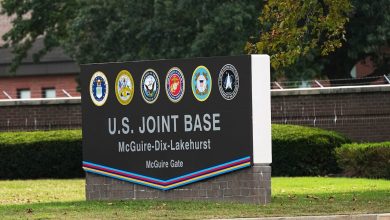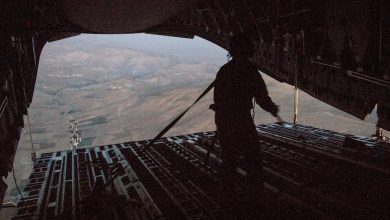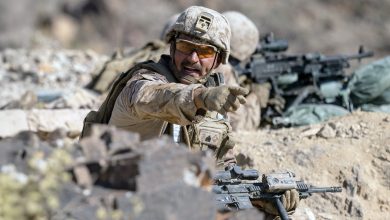The original ‘Lone Ranger’ was killed in WWII — but not by the enemy
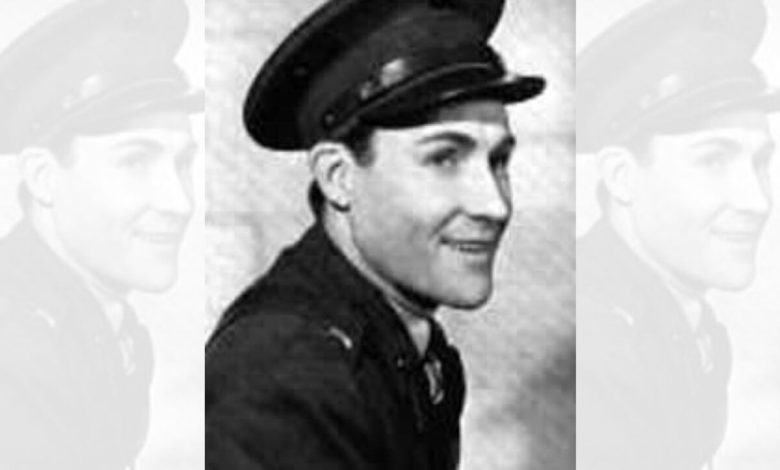
Amid the depths of the American Great Depression, came an American hero that enthralled over 17 million listeners during its debut from radio station WXYZ in Detroit.
Hitting the airwaves in 1933, “The Lone Ranger” depicted a character who was the sole survivor after his group of Texas Rangers was ambushed. Found near death by Tonto, a Native American, the Lone Ranger donned a mask and meted out justice on top of his horse, Silver.
Written by Fran Striker for WXYZ station owner George Trendle, “The Lone Ranger” quickly became a runaway hit, with 1.5 million listeners joining the official fan club after the show’s original debut.
Wanting a piece of success, Hollywood soon got involved, casting Lee Powell as the masked Lone Ranger in 1938, in what was to be the most expensive serial produced at the time.
Powell was seemingly a perfect fit for the character described as tall and athletic. An accomplished horseman, Powell had worked on a ranch in Montana while studying to be a mining engineer. The 30-year-old Powell had been acting in small stock companies as a hobby when he returned to his home state of California and was discovered by the studio while performing in a play, according to the U.S. Naval Institute.
The 15-chapter “The Lone Ranger” was a hit, according to Powell, due to its “Fast riding. Fast shooting. Fast punching.”
Powell sought to capitalize on his fame by touring with the Barnett Brothers Three Ring Circus (later the Wallace Brothers Circus).
“For 25 cents, children were promised the thrill of meeting ‘The Original Lone Ranger of Talking Screen Fame’. … Children could hardly believe that they were seeing the actual Lone Ranger. They would run up and ask to touch and pinch him to see if he was real,” writes the U.S. Naval Institute.
That stardom was short-lived, however, after the circus was hit with a damage suit for using the likeness of the Lone Ranger to sell tickets, as well as Powell shouting out the studio’s copyrighted catch phrase of “Hi-yo, Silver!”
As the litigation drew on, Powell faded into relative obscurity, taking uncredited roles to make ends meet.
However, like the Lone Ranger’s strict moral code: “That men should live by the rule of what is best for the greatest number,” Powell took on a new role and enlisted in the U.S. Marines in August 1942.
As a sergeant in the 2nd Marine Division, he fought in the brutal battles on Tarawa in November 1943 and Saipan in the summer of 1944.

The fighting on day two of Tarawa is considered one of the toughest battles in Marine Corps history. The battle would conclude in an American victory, but at a steep cost. The attack on Betio, the largest and southernmost island in the Tarawa atoll, required a direct assault on the beachheads by U.S. Marines.
Landing on Nov. 20, 1943, the Marines were met with withering fire, poured out by elite troops of the Imperial Navy’s Special Naval Landing Force, sometimes called “Japanese Marines.” Protected by coral reefs, the flat, small island was one of the most heavily fortified in the Pacific, and because of the island’s geography, the nearly 5,000 Marines would have no immediate room to maneuver.
On Saipan, according to the U.S. Naval Institute, Powell was charged with organizing security watches to guard against Japanese snipers who had infiltrated the lines.
On Tinian — famous for the feint tactic in which Marine Gen. Holland Smith declared the invasion, “the most perfect amphibious operation in the Pacific War” — Powell met his end.
The details, however, remain murky.
Powell died July 30, 1944, and newspapers back home soon reported that the original Lone Ranger had been killed in action.
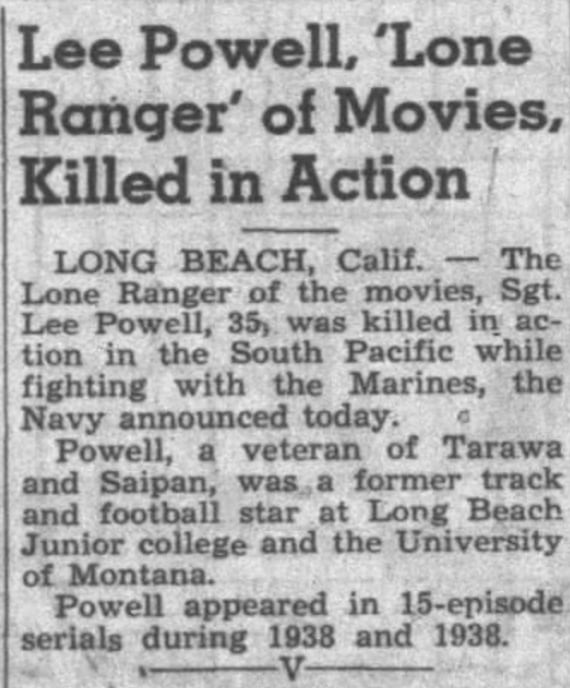
Except he hadn’t been.
In 1999, while researching his book, “Stars in the Corps,” author James Wise discovered that while Powell had been killed on Tinian, it had not been the result of enemy action, as the press claimed.
After digging into his Marine records, Wise discovered that the actor-turned-Marine had died from acute alcohol poisoning while celebrating the successful invasion of Tinian.
“Some veterans of Tinian remember hearing that Powell died and another Marine was temporarily blinded after celebrating the end of the battle by drinking hooch made from methanol. Others heard that Powell drank captured sake that had been poisoned by the Japanese,” writes the U.S. Naval Institute.
Marine records indicate that Powell had been killed as a result of “wood alcohol poisoning.”
Whether from methanol or poisoned sake, the exact circumstances of Powell’s death remain unclear to this day, but the American press, perhaps unwilling to denigrate Powell and in need of a hero, omitted the alcohol-related death from its reporting.
Powell subsequently faded once again into obscurity, with actor Clayton Moore taking on and popularizing the role even further in 1949.
Yet Powell’s heroic deeds on and off the silver screen never faded for one American.
In 1941, a young boy who had been stricken with a serious illness recovered after Powell visited him while touring with the circus. According to the U.S. Naval Institute, Powell and the boy became close and regularly exchanged letters, even while Powell fought in the Pacific. After his death, the boy refused to believe it, insisting that the Lone Ranger actor was still alive but on a “secret mission.”
Powell’s battalion, the 2nd Pioneer Battalion, touched by the young fan’s dedication, adopted the child as their official mascot and continued to send letters to him throughout the remainder of the war.
Powell, initially buried in the Marine Cemetery on Tinian, now rests in the National Cemetery of the Pacific in Hawaii.
Claire Barrett is the Strategic Operations Editor for Sightline Media and a World War II researcher with an unparalleled affinity for Sir Winston Churchill and Michigan football.
Read the full article here




